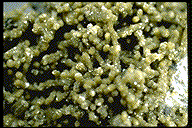 THE MINERAL SUSANNITE
THE MINERAL SUSANNITE
 THE MINERAL SUSANNITE
THE MINERAL SUSANNITE- Chemistry: Pb4SO4(CO3)2(OH)2 , Lead Sulfate Carbonate Hydroxide.
- Class: Carbonates
- Uses: Only as mineral specimens.
Specimens
Susannite is a rare cousin of the mineral leadhillite. The two minerals are dimorphs. A dimorph is a mineral that shares the exact same chemistry with another mineral, but their structures are different (di in latin means two and morph in latin means shape). Typically the different structures make the symmetries different as well. In this case, susannite is a trigonal mineral while leadhillite is monoclinic in symmetry. Susannite is the higher temperature phase of the two and forms when warm fluids oxidize the lead ore deposits. However, leadhillite is the stable form at normal temperatures and pressures and many specimens of susannite may actually have converted to leadhillite.
Such crystals are called paramorphs (para means along or alongside; but in this case, paramorph means same chemistries, but with different structures). Paramorphs are a type of pseudomorph (pseudo means false). A pseudomorph is a crystal that has its internal structure either altered or completely replaced by a different mineral; but still retains its outward shape. Often a pseudomorph is one in which the original mineral is completely different from the pseudomorphing mineral such as when quartz replaces riebeckite for example. In the case of susannite, the internal structure of susannite converts to the more stable structure of leadhillite but retains susannite's rhombohedral form. And since the two minerals are dimorphs, the chemistry stays the same and hence they are paramorphs!
But the confusion does not stop there. There actually is another mineral that has the same chemistry and . . . you guessed it . . . a different structure. The mineral is called macphersonite and is orthorhombic in symmetry. This makes susannite, leadhillite and macphersonite a complete set of trimorphs (the tri means . . . ah, enough already).
PHYSICAL CHARACTERISTICS:
- Color is colorless, white, greenish or yellowish.
- Luster is adamantine to resinous.
- Transparency: Crystals are transparent to translucent.
- Crystal System is trigonal.
- Crystal Habits include platy rhombohedral crystals that may actually be paramorphed into leadhillite.
- Cleavage is perfect in one direction (basal).
- Hardness is 2.5 - 3
- Specific Gravity is 6.5 (very heavy for a translucent mineral)
- Streak is white.
- Other Characteristics Some specimens are
fluorescent . - Associated Minerals include leadhillite, galena, anglesite, linarite and cerussite.
- Notable Occurrences include the type locality at Susanna Mine,
Leadhills, Lanarkshire , Strathclyde, Scotland and the Mammoth-Anthony Mine, Tiger, Pinal County, Arizona. - Best Field Indicators: Crystal habit, color, luster, density and locality.








